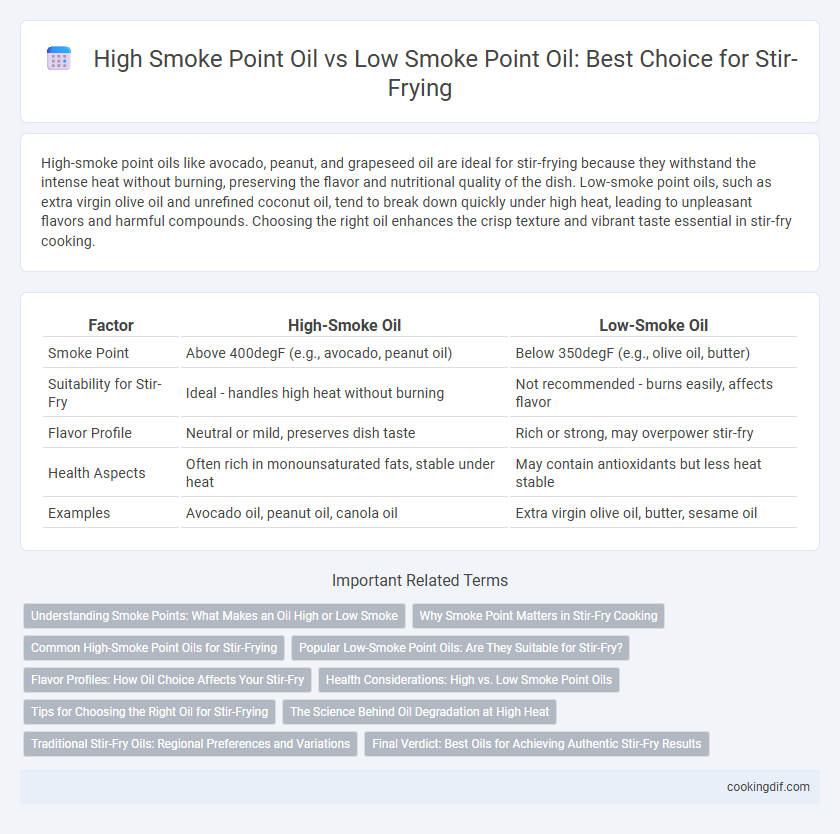High-smoke point oils like avocado, peanut, and grapeseed oil are ideal for stir-frying because they withstand the intense heat without burning, preserving the flavor and nutritional quality of the dish. Low-smoke point oils, such as extra virgin olive oil and unrefined coconut oil, tend to break down quickly under high heat, leading to unpleasant flavors and harmful compounds. Choosing the right oil enhances the crisp texture and vibrant taste essential in stir-fry cooking.
Table of Comparison
| Factor | High-Smoke Oil | Low-Smoke Oil |
|---|---|---|
| Smoke Point | Above 400degF (e.g., avocado, peanut oil) | Below 350degF (e.g., olive oil, butter) |
| Suitability for Stir-Fry | Ideal - handles high heat without burning | Not recommended - burns easily, affects flavor |
| Flavor Profile | Neutral or mild, preserves dish taste | Rich or strong, may overpower stir-fry |
| Health Aspects | Often rich in monounsaturated fats, stable under heat | May contain antioxidants but less heat stable |
| Examples | Avocado oil, peanut oil, canola oil | Extra virgin olive oil, butter, sesame oil |
Understanding Smoke Points: What Makes an Oil High or Low Smoke
High-smoke oils like avocado, peanut, and refined vegetable oils withstand temperatures above 400degF, making them ideal for stir-frying as they prevent burning and maintain flavor integrity. Low-smoke oils such as extra virgin olive oil and unrefined coconut oil have smoke points below 350degF, which can produce harmful compounds and off-flavors when exposed to the high heat typical of stir-frying. Understanding the smoke point, determined by an oil's refinement level and fatty acid composition, is crucial for selecting the proper oil to achieve optimal cooking performance and health-safe meals.
Why Smoke Point Matters in Stir-Fry Cooking
High-smoke point oils such as avocado or peanut oil withstand the intense heat required for stir-frying without breaking down or producing harmful compounds, preserving both flavor and nutritional value. Low-smoke point oils like unrefined olive or flaxseed oil emit smoke quickly, resulting in burnt flavors and potential toxin formation that compromise dish quality. Selecting oils with an appropriate smoke point ensures optimal cooking temperature, maintaining food safety and enhancing the characteristic crisp texture of stir-fried dishes.
Common High-Smoke Point Oils for Stir-Frying
Common high-smoke point oils for stir-frying include peanut oil, avocado oil, and refined sunflower oil, all of which withstand temperatures above 400degF (204degC) without breaking down. These oils maintain flavor integrity and prevent harmful smoke production during high-heat cooking, making them ideal for quick, intense stir-frying methods. Utilizing oils with a high smoke point enhances both the texture and nutritional profile of stir-fried dishes.
Popular Low-Smoke Point Oils: Are They Suitable for Stir-Fry?
Popular low-smoke point oils like extra virgin olive oil and unrefined coconut oil are often avoided for stir-frying due to their tendency to burn at lower temperatures, producing off-flavors and harmful compounds. Stir-frying requires high-heat oils such as refined avocado oil or peanut oil, which have smoke points above 400degF, ensuring quick cooking without smoke or degradation. Using low-smoke point oils can result in a less optimal texture and flavor in dishes like vegetable or chicken stir-fry, impacting both taste and nutritional quality.
Flavor Profiles: How Oil Choice Affects Your Stir-Fry
High-smoke oils like peanut or avocado oil maintain their stability at high temperatures, preserving the vibrant, nutty flavors essential for authentic stir-fry dishes. Low-smoke oils, such as extra virgin olive oil, can break down quickly and impart a bitter or burnt taste, overwhelming delicate ingredients and altering the intended flavor profile. Selecting an oil with an appropriate smoke point enhances the dish's aroma and texture while ensuring a balanced, rich flavor that complements fresh vegetables and proteins.
Health Considerations: High vs. Low Smoke Point Oils
High-smoke point oils such as avocado, peanut, and refined grapeseed oil are ideal for stir-frying because they resist breaking down and producing harmful free radicals at elevated temperatures. Low-smoke point oils like extra virgin olive oil and unrefined coconut oil can release toxic compounds and degrade nutrients when exposed to high heat, posing potential health risks. Choosing oils with high smoke points enhances the nutritional integrity of stir-fried dishes and supports safer cooking practices.
Tips for Choosing the Right Oil for Stir-Frying
High-smoke-point oils like avocado, peanut, or refined canola are ideal for stir-frying as they withstand intense heat without breaking down or producing smoke. Low-smoke-point oils, such as unrefined olive or flaxseed oil, can burn quickly, imparting bitter flavors and unhealthy compounds to the dish. Choose oils based on smoke points above 400degF (204degC) to ensure optimal flavor retention and health benefits during high-heat stir-frying.
The Science Behind Oil Degradation at High Heat
High-smoke point oils like avocado, peanut, and refined safflower oils resist oxidation and thermal breakdown during stir-frying, preserving flavor and nutritional value. Low-smoke point oils such as unrefined olive or flaxseed oils rapidly degrade at high temperatures, producing harmful free radicals and off-flavors due to lipid peroxidation. Understanding oil smoke points and fatty acid stability is essential for maintaining food safety and enhancing stir-fry quality.
Traditional Stir-Fry Oils: Regional Preferences and Variations
Traditional stir-fry oils vary regionally, with high-smoke point oils like peanut oil favored in Chinese cuisine for their ability to endure intense heat without breaking down. In contrast, Southeast Asian cuisines often utilize low-smoke oils such as sesame oil, prized for its distinctive aroma despite lower heat tolerance. Understanding these regional preferences highlights how oil selection impacts flavor and cooking technique in authentic stir-fry dishes.
Final Verdict: Best Oils for Achieving Authentic Stir-Fry Results
High-smoke point oils like peanut, canola, and grapeseed oil excel in stir-frying by withstanding intense heat without breaking down, preserving the authentic wok hei flavor. Low-smoke oils such as extra virgin olive oil or butter tend to burn quickly, producing off-flavors and compromising dish quality. Choosing high-smoke point oils ensures optimal texture, flavor, and health benefits in traditional stir-fry cooking.
High-smoke oil vs low-smoke oil for stir-frying Infographic

 cookingdif.com
cookingdif.com